Camp Leakey - 1st Feeding

Jackamy
Paul & Derry Harper
Fri 12 Nov 2010 10:11
|
Friday 12th November
We arrived at the jetty for
the 3rd station called 'Camp Leakey' around 12:30 and set off to the
camp and feeding session around 13:00. Just enough time for us to apply sun
cream, mosquito repellent and decide on the right attire and
footwear.
Canadian researcher Dr Birute
Galdikas began her research here in 1971. She arrived with her former
husband Mr Rod Brindamour in two dugout canoes carrying with them their
possessions and provisions. This was the beginning of the Orangutan Research and
Conservation Project based at what was to become Camp Leakey. The least
known of the female ape experts mentored by the legendary anthropologist Dr
Louis Leakey, Dr Galdikas' discoveries included the orangutan's eight year birth
cycle, which makes it highly vulnerable to extinction. The project continues to
this day and is one of the longest continuous mammalian studies in the
world.
The 415,000 hectare park was
Indonesia's first site for the now controversial practice of orangutan
rehabilitation: training orphaned or former captive orangutans to live in the
wild. But after prolonged close contact with human rehabilitators, orangutans
never lose their taste for it. Orangutans can also pick up human diseases and
spread them to wild populations. Current regulations require reintroduction in
areas without native orangutan populations. Tanjung Puting's rehabilitation work
is being phased out.
Part of the rehabilitation
process that survives is daily feedings to released orangutans at jungle
platforms and this is where we were headed for 2pm.
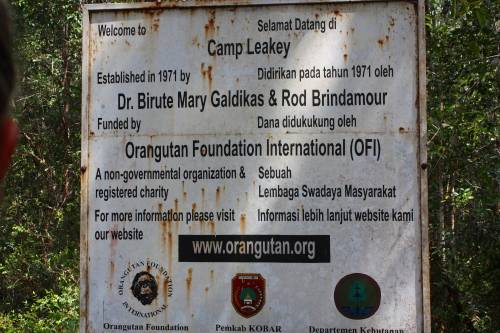 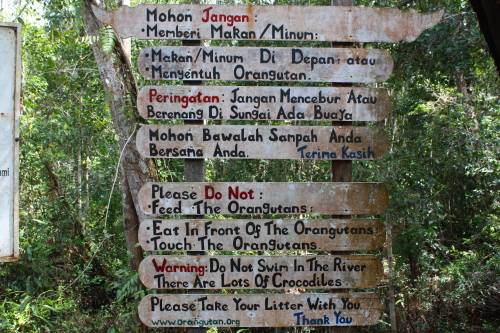 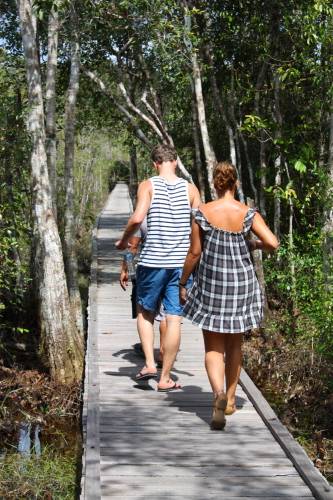 We set off on the 20
minute walk along a timber pontoon into the rainforest away from the
river. We were minding our own business and anticipating what was coming up when
suddenly Thomas came bounding through the trees. Before we knew it he was sat on
the pontoon with us eating an orange. The way he ate it was incredible, he'd
pierce the centre with his nail and peel the skin back, selecting one segment at
a time. Already the intelligence of these animals was clear. There is only 3
percent that separates human DNA from orangutan, which actually means 'person of
the forest' in Malay. Some stay close to the camp and have even learnt to open
doors with keys, row canoes, bail out an when necessary, wash clothes as well as
other sorts of human behaviour. When you look into their brown eyes you know
that they are trying to read your mind as much as you are theirs. They want to
learn as much from us as we do them.
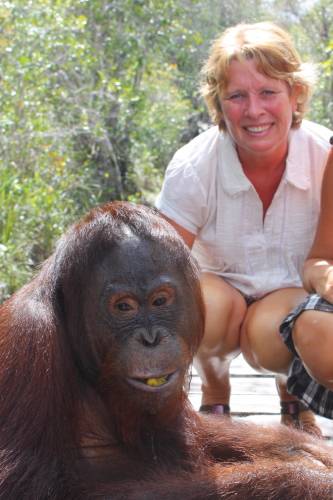 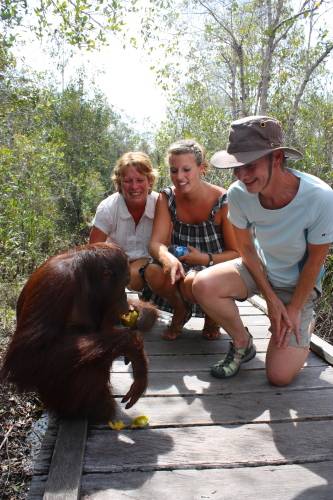 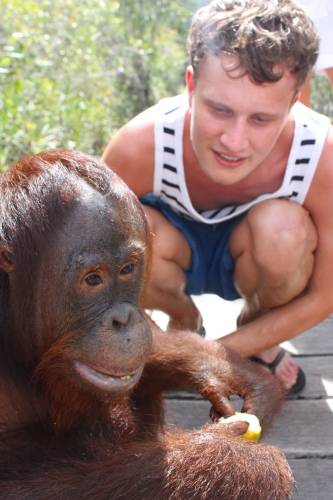 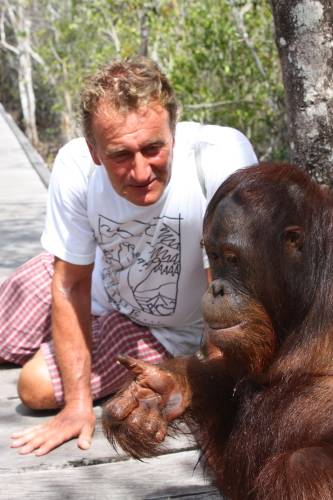 Thomas was a cheeky chappy and
pinched my bottle of water. He instantly clambered down the tree to cool the
warm water in the chilly swamp water below - clever ay! He then held on to the
lid with his teeth as he twisted the bottle back and forth with his hand until
alas it was open and the water ran free. Mysteriously he'd then pour the water
in his mouth and spit it out. Who knows what that was about, but nonetheless he
knew what to do, no doubt through years of observing humans, like a baby learns
from the actions of those around them.
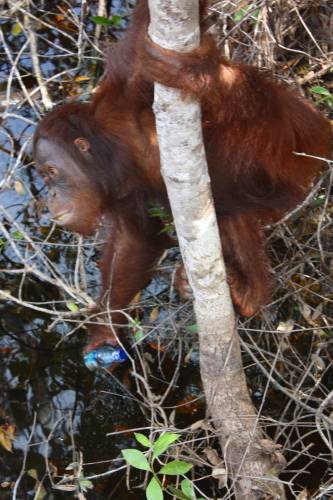 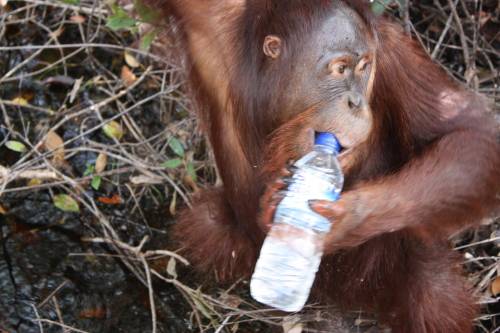 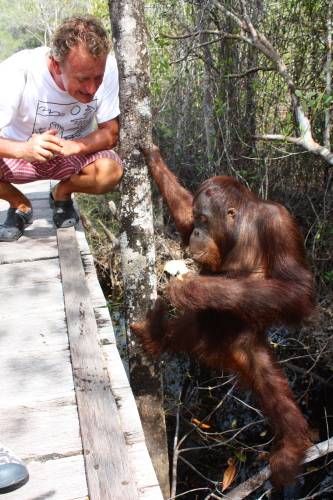 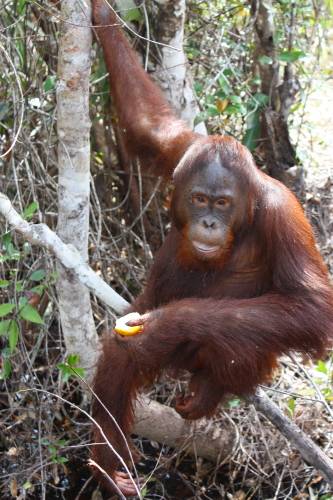 We tore ourselves away from
Thomas and made our way into the camp on a high, our first encounter with an
orangutan had been as perfect as it could have been. It was only the beginning!
A cheeky gibbon jumped from tree to tree and would make you go dizzy if you
watched it. Even he was fascinating to study up close. His legs and arms looked
so sturdy, no doubt because they are made up of solid muscle.
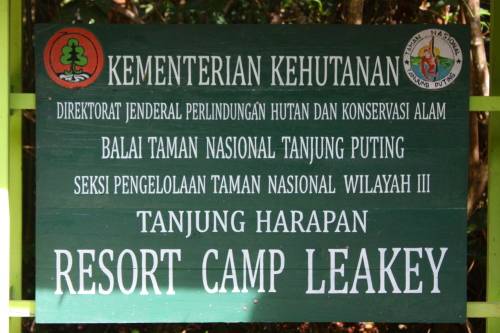 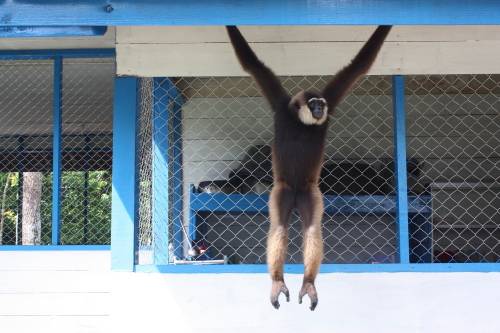
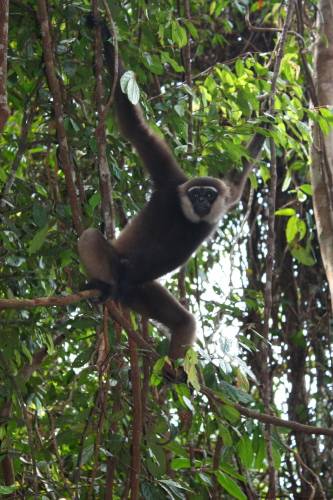 As we turned the corner we came
across 3 more orangutans, Atlas the baby, Unyo and Ahmat. Ahmat who is 43 years
old was the first orphaned orangutan at Camp Leakey and Atlas is her baby. The
young ones all seem to have a mischievous look in their eyes, as if they are
weighing you up and deciding how close they should get or allow you to get.
Whereas the older ones appear used to humans, certainly the ones we met around
the camp anyway, the ones at the feeding table were a different story. But here
in the comfort of their home they seem relaxed and completely at ease and allow
us to kneel down and study them. We watched in amazement as Ahmat ate a bunch of
bananas. Each banana is removed from the bunch separately and popped into the
mouth. The skin is discarded of, not before it is stripped of any banana that
may be left on the inside. 
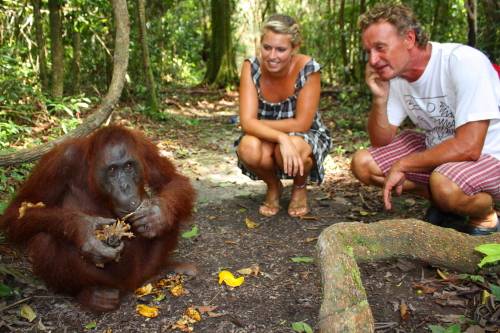 Atlas and Ahmat
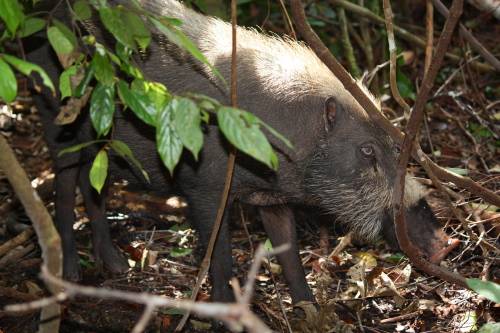 Resident wild boar
Next stop, the information centre
where we were joined by a female and her few month old baby. They sat on the
steps alongside Paul and Jack and shared an orange. It all seemed so natural!
She then reminded us who was boss when she ventured inside the centre and chased
away anyone who attempted to get her out. As gentle and relaxed as these animals
may seem you have to remember that in an instant they could grab you and hurt
you, they are much stronger than we are!

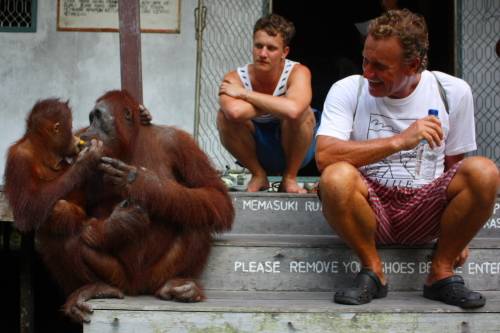 Eventually we made another 20
minute walk further into the jungle to the feeding platform where we could hear
the rangers calling the orangutans. So as not to place any stress on the wild
orangutan population in the park, these supplemental feedings are available
daily for ex-captive rehabilitants. The number of orangutans availing themselves
of this afternoon snack varies greatly. Sometimes no one comes, other days 1 or
2 and then there are days when there are more. Of course, the days when no one
comes is a good sign for the orangutans - it means they are well and happy,
living on the fruits of the forest.
Today we were lucky! Although it
seems almost wrong to say that, as you want there to be orangutans there but
then at the same time you don't, as you want them to be surviving out in the
jungle by themselves. Perhaps they've become lazy or greedy and come back here
as they know there'll be food. The good thing is that these ones who are just
that little bit further away from the camp are definitely not as friendly. Don't
get me wrong, I didn't ever feel in any danger but they certainly
weren't as welcoming or friendly. I don't think we'd find one of these bounding
through the trees to join us on the pontoon and hold our hand.
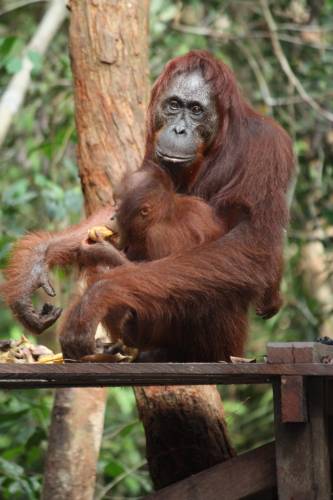
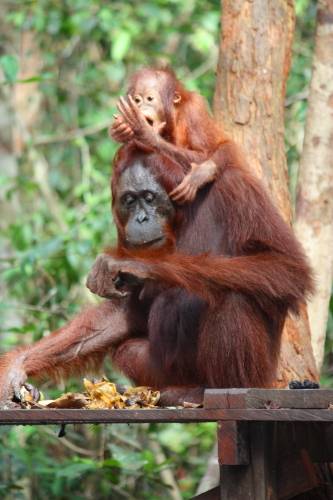 Mother and baby
Very often the orangutans would
climb down from the trees, grab some bananas and venture back up into the tree
tops. They are nature's largest arboreal animal and rarely come to the ground,
building up to a half-dozen nests daily for sleeping. The nests consist of a
bunch of leaves and twigs bunched together - how it supports their weight is a
mystery! They are crucial to the rainforest as seed dispersers, and the forest
is crucial to them. They forage over large ranges, eating more than 200
varieties of fruit, bark and leaves, plus occasional insects and
meat.
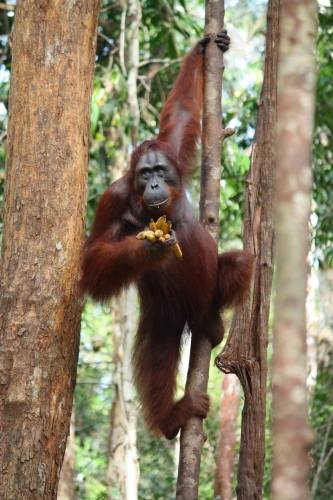
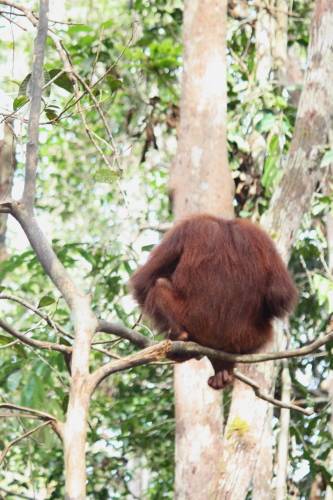 Ironwood is as strong as steel
- that is how that small branch is supporting him!
Just as we'd returned back to the
boat Seeswee came sauntering down the pontoon - a fully grown adult female,
complete with the huge jowl. Once again we witnessed an orangutan eat an orange,
she had the same method, except she was fussy about the pips. After each segment
had been placed in her mouth a pip would come flying out, still
whole.
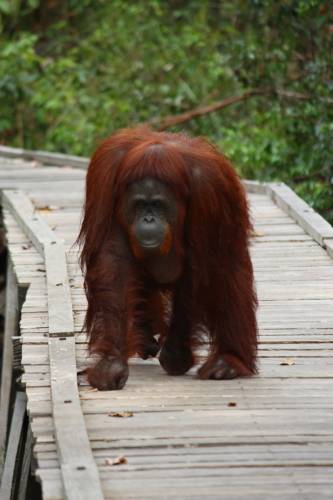
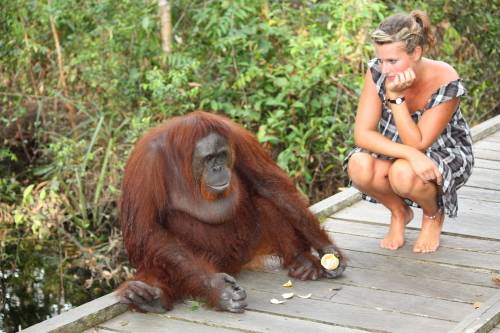 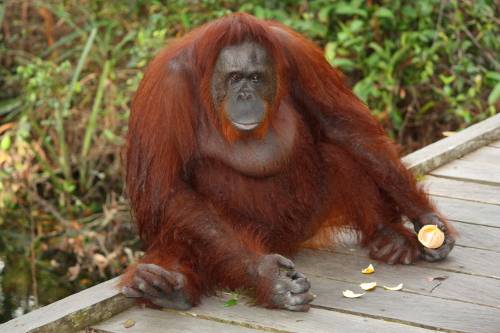
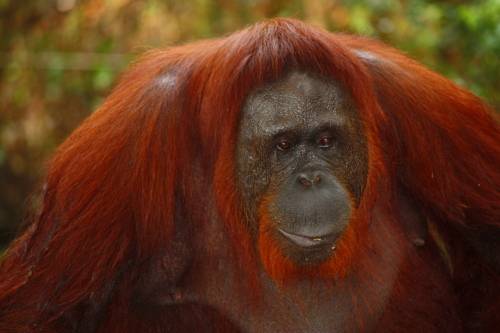 
 We were slightly nervous as we
retreated to the boat to eat our banana fritters cooked by Topik. As she
ventured towards the edge of the pontoon we thought she could smell them
and was coming for a treat. Instead she made her way down the steps and
dangled her feet in the water to cool her down, followed by a drink of water
from Joe.
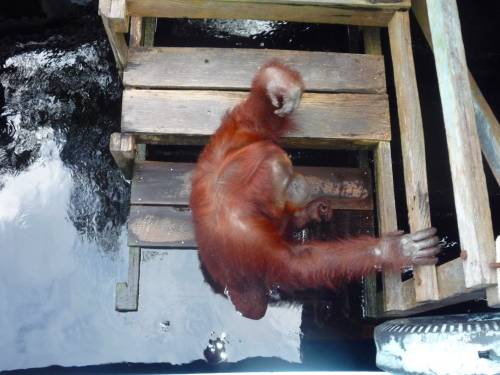
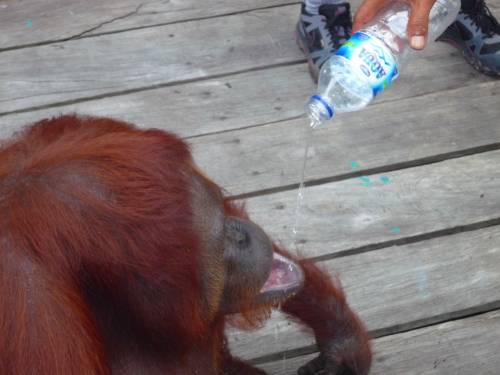 We left the pontoon to tie up to
the trees on the other side of the river, just a few metres away from the
orangutans and even closer to the proboscis monkeys in the trees above. It was
time to reflect on the days events and settle into the evening aboard our
temporary home. The painted ironwood boat is around 15 metres long and 2 metres
wide with a roof that formed the upper deck, where we lived and slept for the 3
days and 2 nights. The crew lived and worked and slept inside the
boat.
The toilet and showering
arrangements are what had caused the most concern, as again we'd seen pictures
of other boats with uncovered shared toilet and showers. Ours however, was first
class! The toilet and shower were in separate large compartments
and considering that we were on board a klotok I'd say there were pretty
good. A delicious dinner was served just before darkness fell and then we
watched a dvd about when Julia Roberts visited the same camp in 1994. From then
on everything was conducted under candle light. We deemed this to be a good
thing as the candle light hid the bugs that had found they way into the boat -
out of sight, out of mind!
The crew assembled our beds,
starting with a 6 inch think mattress, sheets, pillows and then mosquito nets
suspended across the ceiling. Such simplicity!
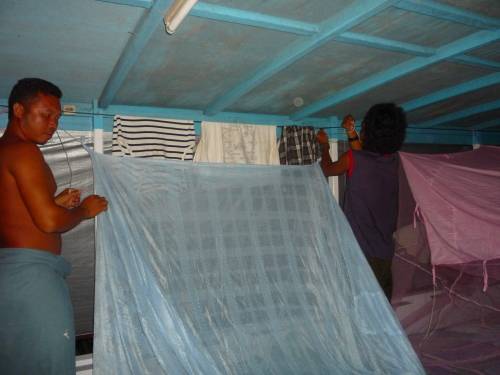 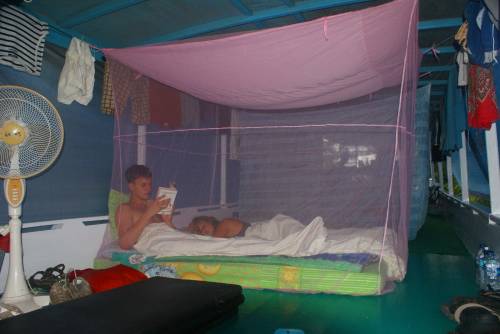 Topik and I Ben assembling the
beds.........Not long before Amy and Jack were in!
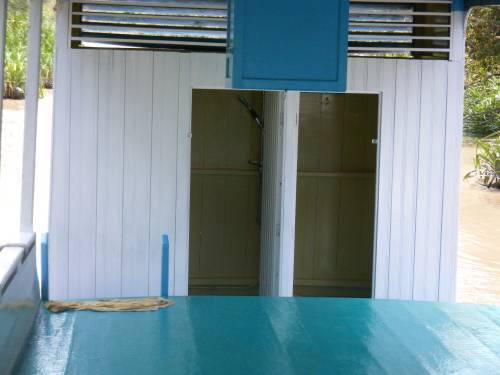 The shower to the left and
toilet to the right
|